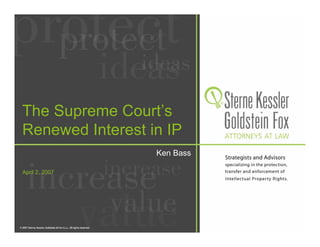SKGF_Presentation_The Supreme Courts Renewed Interest In IP_April 2007
- 1. The Supreme Court’s Renewed Interest in IP Ken Bass April 2, 2007
- 2. Who is this guy? • Clerk for Justice Hugo Black (1969 Term) • Private Practice focusing on appellate cases since 1970 • Joined SKGF in 2000 • Adjunct Professor of Appellate Practice at Georgetown • Past President American Academy of Appellate Lawyers • Involved in Supreme Court Patent cases • Co-counsel in KSR v. Teleflex 2
- 3. Looking Back at History • The Supreme Court’s View of IP law in the early 1970’s – A technical, fairly arcane field – A subject of “lesser importance” – Judicial self-awareness of limitations • The lack of regional consistency • The “National Court of Appeal” movement 3
- 4. The Birth of the Federal Circuit • The 1975 Conference on Appellate Justice • The “National Court of Appeals” proposal meets resistance • The focus shifts to a “specialized” nationwide court for patent cases • The birth of the CAFC in 1982 4
- 5. The Supreme Court’s Initial Reaction • Wait and See • IP issues remained of secondary public importance • The Court’s membership had not changed all that much • The “Percolation” Policy 5
- 6. The Picture Begins to Change • Markman v. Westlaw Instruments – April,1996 – 517 U.S. 370 – CAFC decision • Judges, not juries, decide issues of claim construction – Supreme Court decision • Agreed! 6
- 7. An “Outlier” Contributes to Change • Nelson v. Adams USA – April, 2000 – 529 U.S. 460 – CAFC decision • Attorney’s fees awarded against individual who in fact controlled the defendant corporation and was added as a party after trial – Supreme Court decision (unanimous) • Improper to sanction someone not a party at the trial and thus no sanctions can be imposed 7
- 8. The Pace of Change Quickens • Festo v. Shoketsu – May, 2002 – 535 U.S. 722 – The CAFC decision • Any amendment forecloses DOE – The Supreme Court decision (unanimous) • Flexibility restored 8
- 9. The Pace of Change Quickens (cont.) • Holmes v. Vornado – June, 2002 – 535 U.S. 826 – The CAFC decision • Per Curiam – the CAFC has appellate jurisdiction over patent counterclaims based on long-standing CAFC precedent – The Supreme Court decision (unanimous) • No you don’t! 9
- 10. The Growing “Tension” • eBay v. MercExchange – May, 2006 – 126 S. Ct. 1837 – The CAFC decision • Final injunctions are almost automatic once there is a finding of infringement and validity – The Supreme Court decision • No presumption of issuance, the same rules apply as in all civil litigation • Two different thumbs on the scale – Justice Kennedy – The Chief Justice 10
- 11. The Growing Tension (cont.) • MedImmune v. Genentech – January, 2007 – 127 S. Ct. 764 – The CAFC decision • No Article III standing if a licensee in good standing contests patent validity – The Supreme Court decision • There is an Article III case and controversy (8-1 decision) 11
- 12. • KSR v. Teleflex – ???? 2007 – The CAFC decision • Applied the well-established TSM test for determining obviousness as a first hurdle – The arguments at the Supreme Court • Wide hostility to an absolute, first hurdle approach – What’s likely to emerge? 12
- 13. What Does it All Mean? • The Supreme Court has become engaged – once again – in IP issues • The Supreme Court is not “happy” with the CAFC’s handling of patent issues • The Supreme Court dislikes “bright-line” rules • The Supreme Court avoids giving clear guidance on how patent cases should be decided • The Supreme Court recognizes the central importance of IP in today’s “flat world” economy 13













